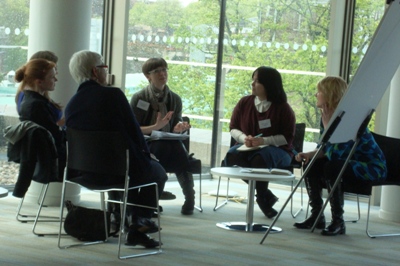Enhancing the Value of Collections: Investigation and Preservation
Printable version of this text: Research Network Enhancing Value of Collections Meeting
20 participants from the UK, Ireland, the Netherlands, Portugal and the USA attended the fourth meeting of the Research Network, Enhancing the Value of Collections: Investigation and Preservation, on 30 March 2012.
The aim of the day was to identify key concerns which would feed into potential research projects in the field of conservation, specifically in textile conservation. Participants represented major collections, including the Victoria & Albert Museum, the National Trust, Historic Royal Palaces, the Metropolitan Museum of Art in New York and Glasgow Museums. The areas of interest which conservators brought to the meeting were wide ranging, including object biography and issues of use and re-use and their impact on conservation; the communication of conservation to members of the public and the public perception of conservation; the documentation and display of costume; materials analysis; the re-treatment of objects, particularly iconic objects, and the long-term effects of open display.
Three of the participants gave short presentations to start the discussions, explaining their own context for research into textile conservation. Maria Jordan explained how the two scientists work with the preventive and interventive conservation teams at Historic Royal Palaces to investigate issues of concern for individual objects, while the recolouration project, lighting one of the Abraham tapestries to demonstrate its original colours, was extremely successful in enhancing visitor understanding of this often overlooked group of artefacts. Ksynia Marko outlined the National Trust research strategy and explained how conservation research will help to assess the impact on collections of new policies such as increasing access for visitors and extended opening hours, as well as external factors such as climate change. Margriet van Eikema Hommes (Delft University of Technique) explained the findings of technical research into five large 17th century wall hangings by Bol. Collaborative research by art historians and conservators provided a great deal of information about the hangings’ lives, showing how they were made and used.
Discussions focused on how we can gather data on which to base sound conservation decisions, both physical evidence from objects and social science data. Some of the topics proposed for research projects were:
- Is it really cheaper to put objects on open display? What are the hidden costs?
- Do visitors really prefer open display? What is its emotional value? How can we find out?
- When can a replica stand in for an object? How does the visitor experience compare?
- Risk assessment protocols: developing an objective approach for conservators, curators and other decision makers
- Pest control – assess effects of re-treatments and of commercial controls
- Further research into dust deposition
- Cycle of testing conservation materials
- Using object biographies to enhance the visitor experience and our knowledge of collections
- Capturing crafts and skills in terms of materials, techniques and cultural meaning
We would like to extend our very warm thanks to all the participants who made such significant contributions to the day’s discussions.
Conference 2012: The Real Thing
The network will end with a conference at the University of Glasgow on 6-7 December 2012: ‘The Real Thing?’ The Value of Authenticity and Replication for Investigation and Conservation. The conference promises to be really interesting with contributions from the V&A, the British Museum, the Metropolitan Museum of Art, West Dean Tapestry Studio, the National Gallery and others. Further details will be circulated soon.
Frances LennardApril 2012


